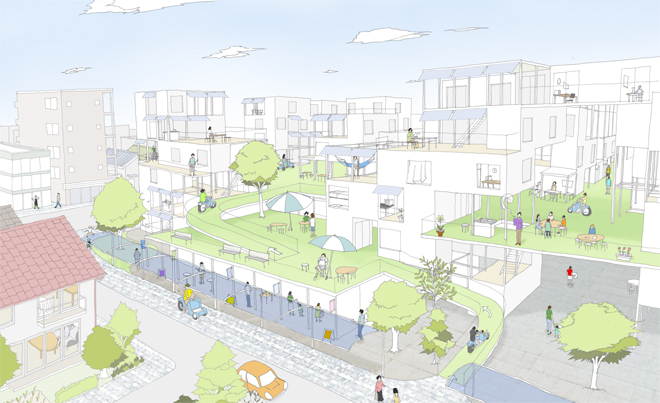Local Community Area



How People Live in a Local Community
Today’s system of government is premised on self-help by the one house = one family unit. However, that social unit is becoming increasingly useless. Then what other ways of dwelling are there? What sort of administrative system is possible? Let us consider a unit composed of approximately 500 people. It could just as well be 400 or 700 people. The number will differ depending on the characteristic of the locality. This will be one ”local community area”. What ways of dwelling are possible for these people? What system of mutual-aid can we develop?
First, housing. Housing for sale is too burdensome for individuals. Such a form of housing is unable to adapt to major social changes. Housing will therefore be for rental. As much space as possible will be given over to common areas, and areas over which individuals have exclusive rights will be made small. Here, we call the housing from which the local community area is composed ”ie”. An ”ie” is made up of a ”mise”and a ”nema”. This room organization is entirely different from that of the traditional LDK-type unit (Living- Dining- Kitchen). The “mise” is glazed on the outside. The “nema” is a highly private place. People are free to rent space any way they want. They can, for example, rent a large “mise” portion and use it literally as a shop. It can also be used as an office or an atelier. Or it can be a porch-like space where an elderly person can take a nap or a child can play. People can also rent a large “nema” portion and create an “ie” that is like a highly private traditional house. Toilets, showers and mini-kitchens will be shared. Toilets and showers will be made as spacious as possible and provided in sufficient numbers. Even so, this arrangement will be far more efficient than providing such facilities for each one house = one family unit. The relationship between areas over which individuals have exclusive rights and shared areas has been completely reconsidered. Relationships having to do with energy, transportation, care, nursing, welfare and local economy on which one house = one family was premised have been all reconsidered. Those reconsidered relationships constitute a local community area.
Today’s system of government is premised on self-help by the one house = one family unit. However, that social unit is becoming increasingly useless. Then what other ways of dwelling are there? What sort of administrative system is possible? Let us consider a unit composed of approximately 500 people. It could just as well be 400 or 700 people. The number will differ depending on the characteristic of the locality. This will be one ”local community area”. What ways of dwelling are possible for these people? What system of mutual-aid can we develop?
First, housing. Housing for sale is too burdensome for individuals. Such a form of housing is unable to adapt to major social changes. Housing will therefore be for rental. As much space as possible will be given over to common areas, and areas over which individuals have exclusive rights will be made small. Here, we call the housing from which the local community area is composed ”ie”. An ”ie” is made up of a ”mise”and a ”nema”. This room organization is entirely different from that of the traditional LDK-type unit (Living- Dining- Kitchen). The “mise” is glazed on the outside. The “nema” is a highly private place. People are free to rent space any way they want. They can, for example, rent a large “mise” portion and use it literally as a shop. It can also be used as an office or an atelier. Or it can be a porch-like space where an elderly person can take a nap or a child can play. People can also rent a large “nema” portion and create an “ie” that is like a highly private traditional house. Toilets, showers and mini-kitchens will be shared. Toilets and showers will be made as spacious as possible and provided in sufficient numbers. Even so, this arrangement will be far more efficient than providing such facilities for each one house = one family unit. The relationship between areas over which individuals have exclusive rights and shared areas has been completely reconsidered. Relationships having to do with energy, transportation, care, nursing, welfare and local economy on which one house = one family was premised have been all reconsidered. Those reconsidered relationships constitute a local community area.
Function
Housing
architects
Riken Yamamoto & FIeld Shop
construction
2012 (Theoretical Project).
